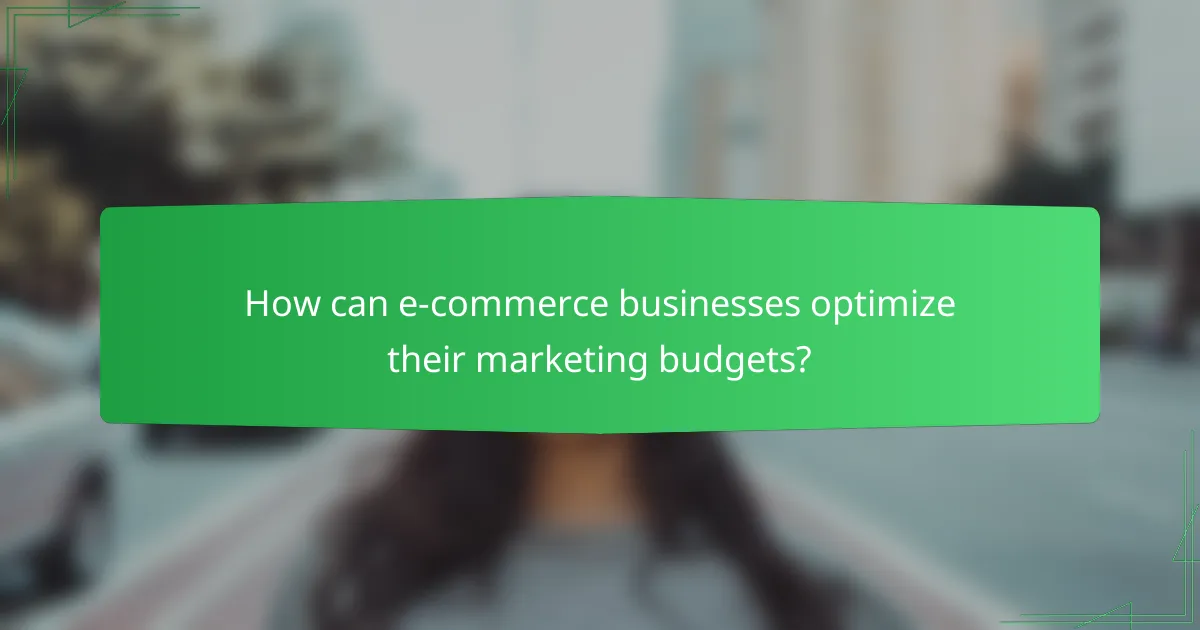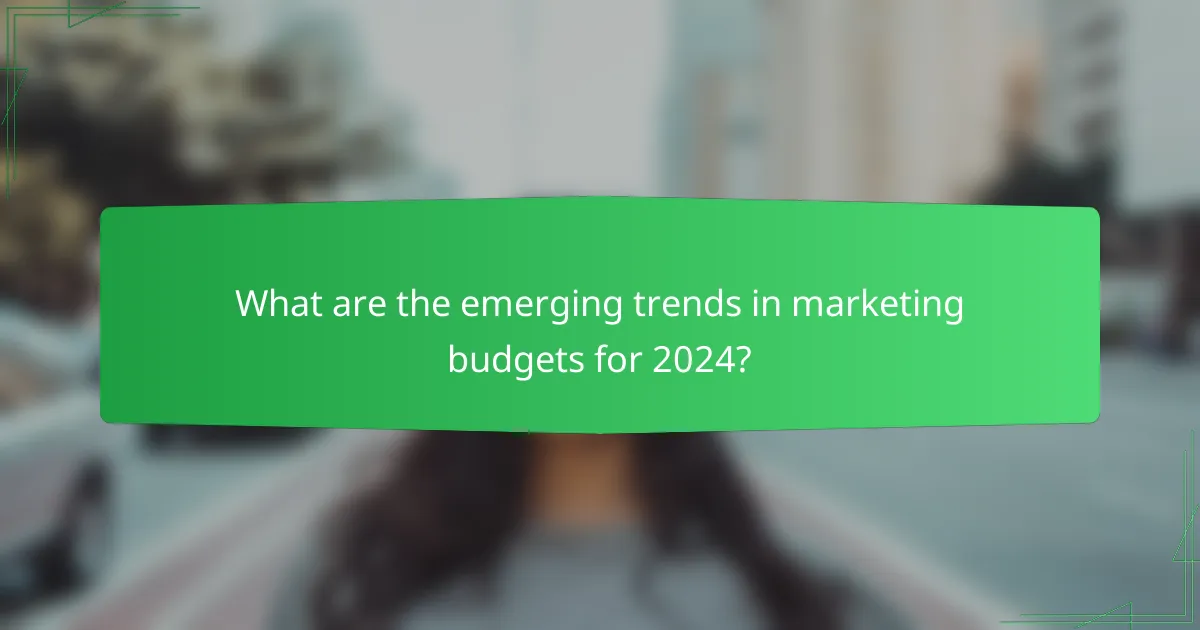Effective marketing budgets are crucial for businesses aiming to maximize their outreach and promotional efforts. In the UK, a significant portion of marketing funds is directed towards digital channels, reflecting the shift in consumer engagement. By understanding key factors such as target demographics and market competition, businesses can strategically allocate their resources to enhance their advertising impact and optimize spending.

What are the typical marketing budget allocations in the UK?
In the UK, marketing budget allocations typically vary based on business size and industry, but common trends show a significant focus on digital channels. Businesses often allocate around 40-50% of their marketing budgets to digital advertising, with traditional media and promotional strategies receiving the remainder.
Digital advertising costs
Digital advertising costs in the UK can range from a few hundred to several thousand pounds per month, depending on the platforms used and campaign complexity. Key channels include social media, search engines, and display ads, with costs influenced by factors such as audience targeting and ad format.
For example, pay-per-click (PPC) campaigns on Google Ads may require a budget of £1,000 to £5,000 monthly for effective reach. Social media advertising can be more flexible, allowing smaller businesses to start with budgets as low as £100 per month.
Traditional media spending
Traditional media spending typically encompasses print, television, and radio advertising, which can be more costly than digital options. Businesses might allocate 20-30% of their marketing budgets to these channels, depending on their target audience and campaign goals.
For instance, a local radio ad can cost between £200 and £1,000 for a short campaign, while national television spots can run into the tens of thousands. Companies should weigh the potential reach against the investment to determine the best approach.
Promotional strategy investments
Investments in promotional strategies often include discounts, special offers, and loyalty programs, which can drive customer engagement and sales. Businesses might set aside 10-20% of their marketing budgets for these initiatives, focusing on tactics that resonate with their target demographics.
For example, a seasonal promotion might involve a 20% discount on select products, requiring a budget for marketing materials and advertising. Tracking the return on investment (ROI) from these promotions is crucial to assess their effectiveness.
Outreach efforts budget
Outreach efforts, such as public relations and community engagement, typically receive around 5-15% of the marketing budget. These activities aim to build brand awareness and foster relationships with the community and media.
Effective outreach might include hosting events, sponsoring local initiatives, or engaging with influencers. Businesses should consider the potential long-term benefits of these efforts against the immediate costs to ensure a balanced approach to their marketing strategy.

How can e-commerce businesses optimize their marketing budgets?
E-commerce businesses can optimize their marketing budgets by focusing on data-driven decisions, implementing cost-effective strategies, and leveraging social media platforms. These approaches help maximize outreach while minimizing unnecessary expenditures.
Utilizing data analytics
Data analytics allows e-commerce businesses to track customer behavior, campaign performance, and market trends. By analyzing this data, companies can identify which marketing channels yield the highest return on investment (ROI) and adjust their budgets accordingly.
For instance, using tools like Google Analytics can help businesses understand which products are popular and which ads convert best. This information can guide future marketing efforts and budget allocations, ensuring resources are spent where they are most effective.
Implementing cost-effective strategies
Cost-effective marketing strategies, such as content marketing and email campaigns, can significantly reduce expenses while reaching a broad audience. Creating valuable content that addresses customer needs can attract organic traffic and build brand loyalty without hefty advertising costs.
Additionally, consider using pay-per-click (PPC) advertising with a strict budget cap to control spending. This allows businesses to test different ads and keywords without overspending, adjusting based on performance metrics.
Leveraging social media platforms
Social media platforms offer a cost-effective way to engage with customers and promote products. By creating targeted ads on platforms like Facebook and Instagram, e-commerce businesses can reach specific demographics without large budgets.
Moreover, organic social media strategies, such as posting engaging content and interacting with followers, can enhance brand visibility at little to no cost. Regularly analyzing engagement metrics can help refine these strategies for better results.

What are the key factors influencing marketing costs?
The key factors influencing marketing costs include target audience demographics, market competition levels, and seasonal trends in spending. Understanding these elements helps businesses allocate their budgets more effectively and optimize their marketing strategies.
Target audience demographics
Target audience demographics significantly affect marketing costs as they determine the channels and messages that resonate best. Factors such as age, gender, income, and location can influence how much a business needs to spend to reach its ideal customers.
For example, targeting a younger audience may require investment in social media platforms, while reaching an older demographic might necessitate traditional media like print or television. Businesses should analyze their audience to tailor their marketing efforts and budget accordingly.
Market competition levels
The level of competition in a market directly impacts marketing costs. In highly competitive industries, businesses may need to spend more on advertising to stand out and capture consumer attention. This can lead to higher costs per click in digital advertising or increased rates for prime advertising slots.
To manage these costs, companies should conduct competitive analysis to identify their unique selling propositions (USPs) and focus their marketing efforts on those strengths. This approach can help reduce unnecessary spending while still effectively reaching potential customers.
Seasonal trends in spending
Seasonal trends can cause fluctuations in marketing costs, as certain times of the year may see increased consumer spending. For instance, holidays and special events often lead to higher advertising rates due to increased demand for ad space.
Businesses should plan their marketing budgets around these seasonal trends, allocating more resources during peak times while considering potential discounts or promotions to attract customers. Monitoring past spending trends can help in forecasting future marketing expenses effectively.

What promotional strategies yield the best ROI?
Promotional strategies that yield the best return on investment (ROI) typically include email marketing, influencer partnerships, and content marketing. Each of these approaches can effectively engage audiences and drive conversions when executed thoughtfully.
Email marketing effectiveness
Email marketing remains one of the most cost-effective promotional strategies, often boasting high ROI. Businesses can expect returns ranging from 4 to 44 times their investment, depending on the quality of their lists and the relevance of their content.
To maximize effectiveness, focus on segmenting your audience and personalizing messages. Utilize A/B testing to refine subject lines and content, ensuring that your emails resonate with recipients. Avoid common pitfalls like sending too frequently, which can lead to unsubscribes.
Influencer partnerships
Influencer partnerships can significantly enhance brand visibility and credibility. Collaborating with influencers who align with your brand values can lead to increased engagement and sales, especially among younger demographics.
When considering influencer partnerships, assess their audience demographics and engagement rates. Micro-influencers, with smaller but highly engaged followings, often provide better ROI compared to larger influencers. Establish clear goals and metrics to evaluate the success of these collaborations.
Content marketing strategies
Content marketing strategies focus on creating valuable, relevant content to attract and retain a target audience. This approach can lead to higher organic traffic and improved customer loyalty over time.
To implement effective content marketing, develop a content calendar that aligns with your audience’s interests and pain points. Utilize various formats such as blogs, videos, and infographics to engage different segments. Regularly analyze performance metrics to refine your strategy and ensure you are meeting your audience’s needs.

How do outreach efforts impact brand visibility?
Outreach efforts significantly enhance brand visibility by fostering connections with target audiences and increasing awareness. These initiatives help brands establish a presence in their communities, build trust, and create lasting relationships with potential customers.
Community engagement initiatives
Community engagement initiatives focus on building relationships within local areas, often through events or sponsorships. These efforts can include hosting workshops, participating in local fairs, or supporting charitable causes. By actively engaging with the community, brands can increase their visibility and demonstrate their commitment to local values.
For example, a small business might sponsor a local sports team, which not only promotes the brand but also fosters goodwill among community members. This type of engagement can lead to increased customer loyalty and word-of-mouth referrals.
Public relations campaigns
Public relations campaigns are designed to shape public perception and enhance brand reputation through media coverage and strategic messaging. These campaigns can involve press releases, media events, or influencer partnerships to reach a wider audience. Effective PR can elevate a brand’s profile and create positive associations in the minds of consumers.
Brands should consider targeting specific media outlets that resonate with their audience, ensuring that their messaging aligns with the interests of potential customers. For instance, a tech startup might collaborate with tech bloggers to showcase innovative products, thereby increasing visibility among tech enthusiasts.
Collaborations with local businesses
Collaborating with local businesses can amplify outreach efforts by leveraging shared audiences and resources. Partnerships can take various forms, such as co-hosting events, cross-promoting products, or creating bundled offers. These collaborations not only enhance visibility but also foster a sense of community among local enterprises.
For example, a coffee shop might team up with a local bakery to offer a special discount on breakfast items, attracting customers from both businesses. Such partnerships can effectively increase foot traffic and brand recognition in the local market.

What are the emerging trends in marketing budgets for 2024?
In 2024, marketing budgets are increasingly focused on integrating advanced technologies and sustainable practices. Companies are allocating more resources towards artificial intelligence tools and environmentally friendly strategies to enhance their outreach and brand reputation.
Increased investment in AI tools
Businesses are recognizing the value of artificial intelligence in optimizing marketing budgets. AI tools can analyze consumer behavior, predict trends, and automate campaigns, leading to more efficient spending and better ROI.
For instance, companies might allocate 20-30% of their marketing budget to AI-driven analytics platforms or chatbots that enhance customer engagement. This shift not only improves targeting but also reduces manual labor costs.
Focus on sustainability in marketing
Sustainability is becoming a key component of marketing strategies, influencing budget allocations. Brands are investing in eco-friendly practices and messaging to appeal to environmentally conscious consumers.
Marketers might consider dedicating a portion of their budget—around 10-15%—to sustainable initiatives, such as using recycled materials for promotional items or supporting green causes. This not only enhances brand image but also aligns with consumer values, potentially increasing customer loyalty.
